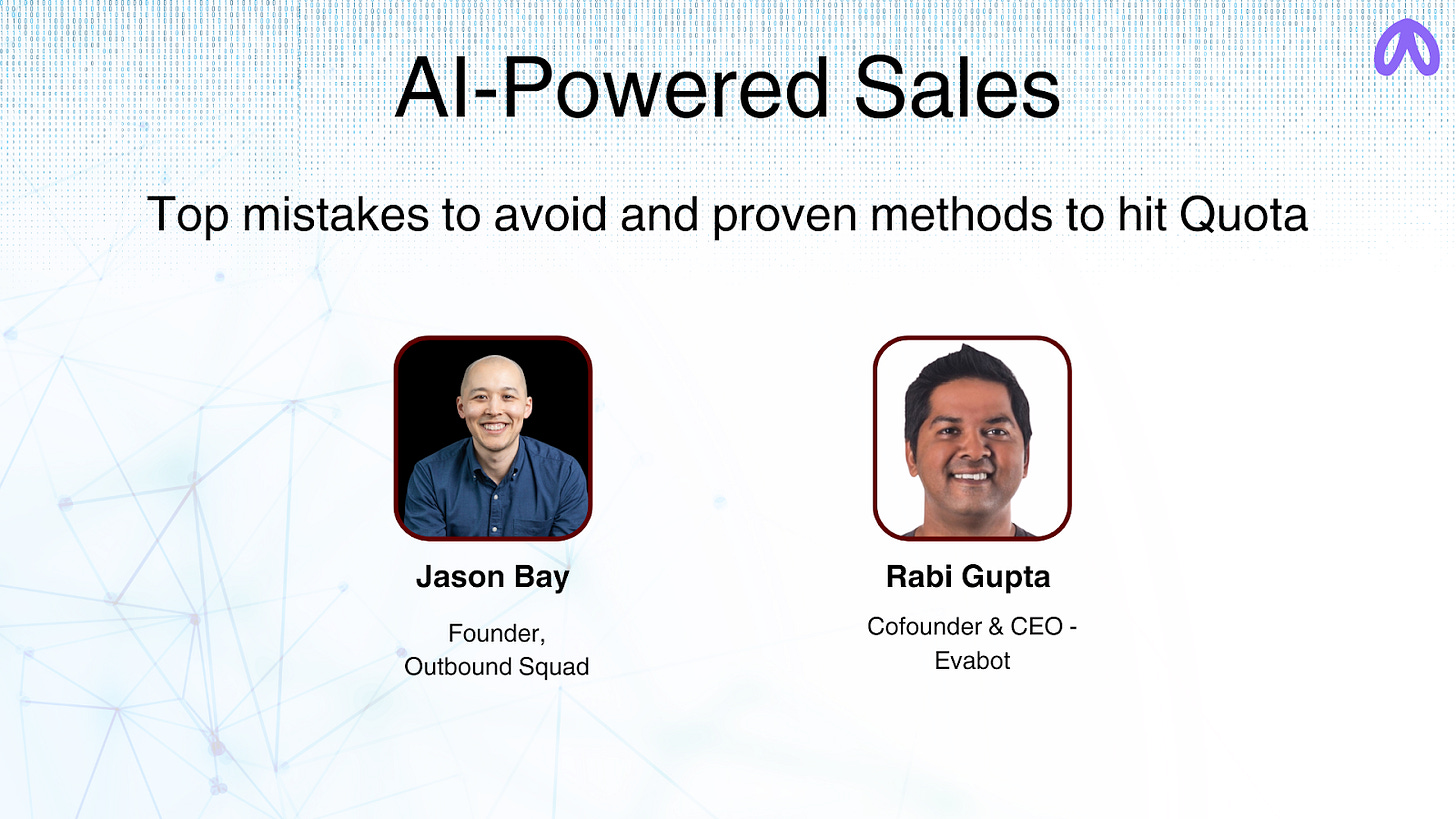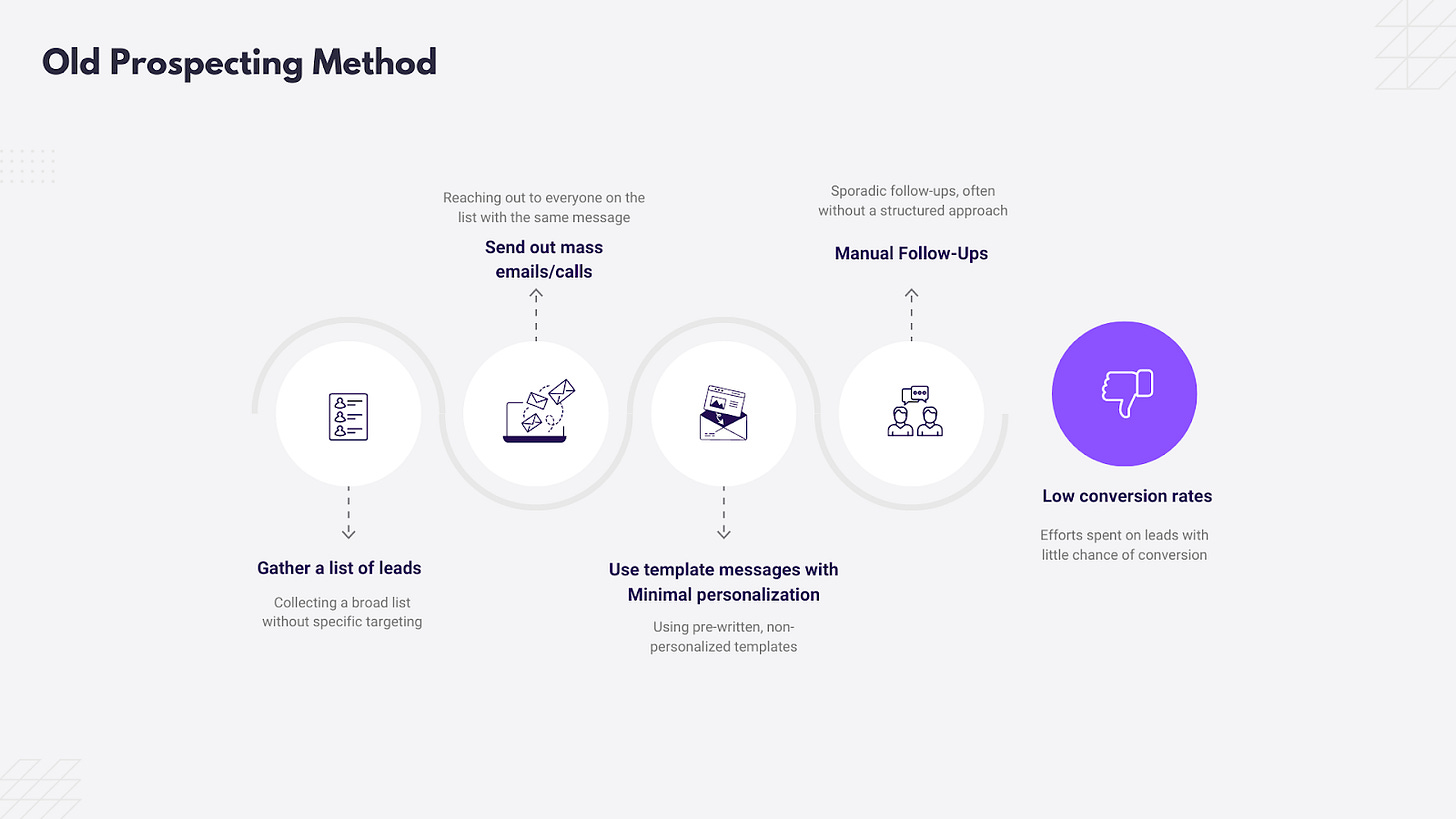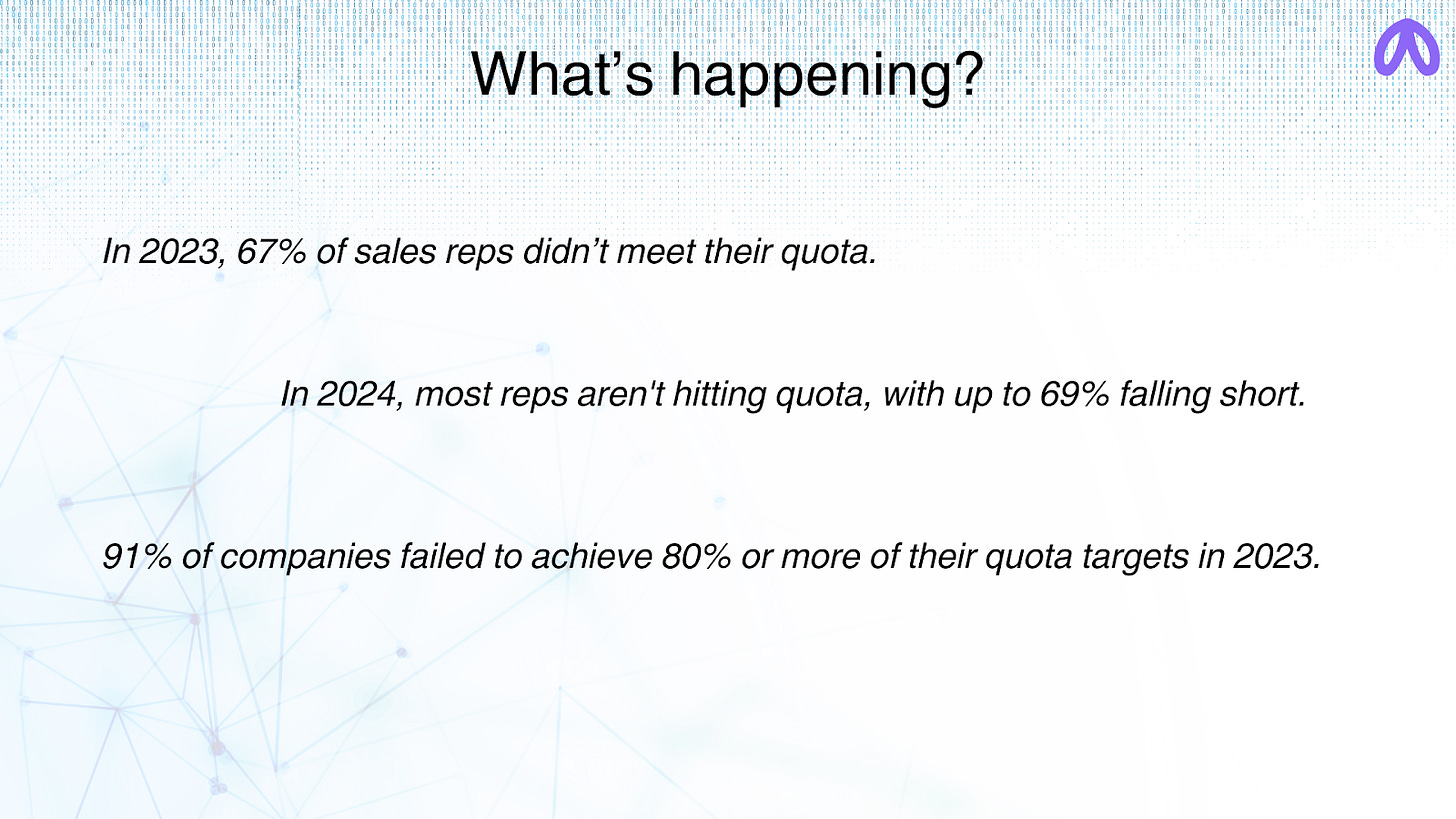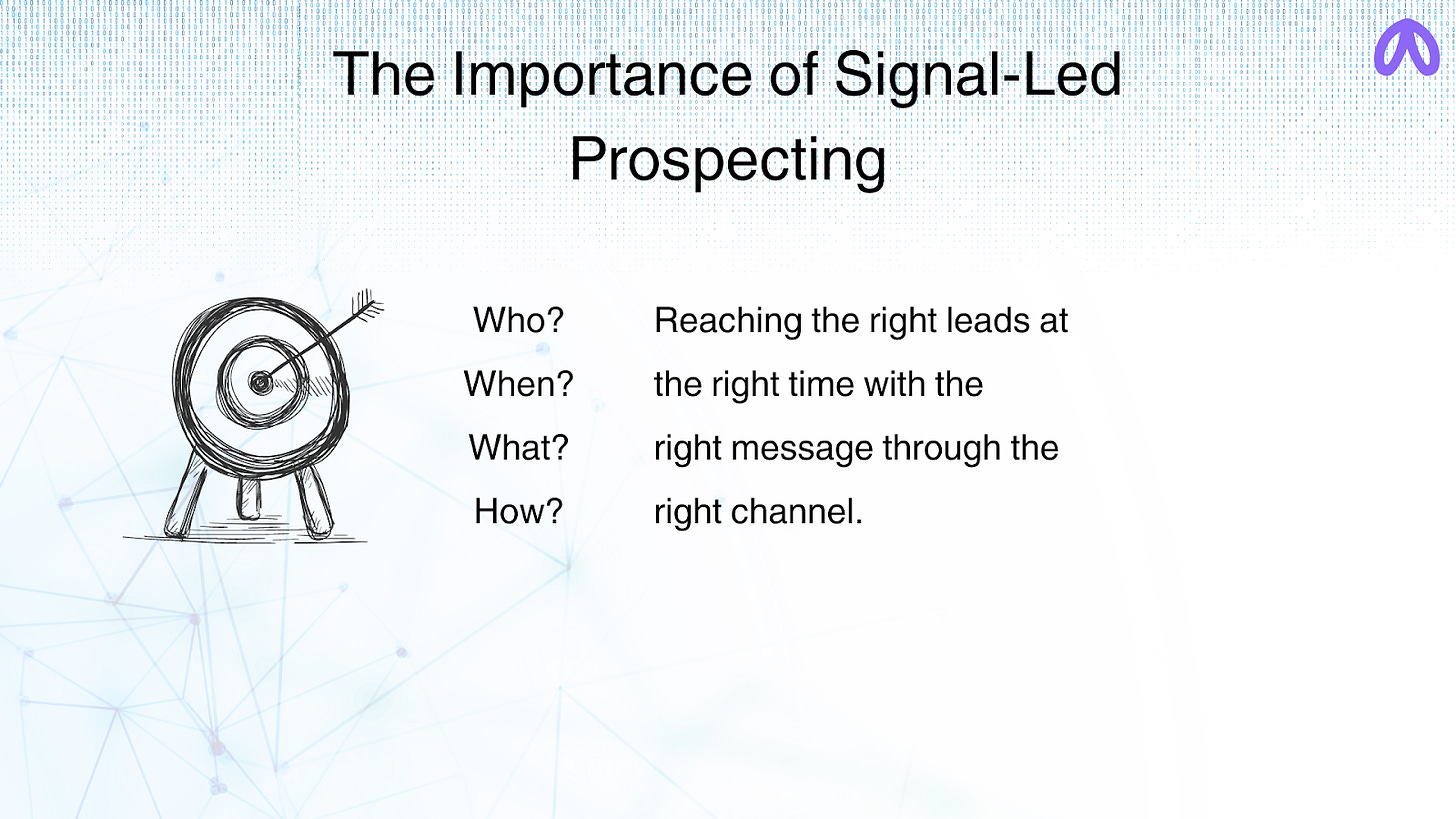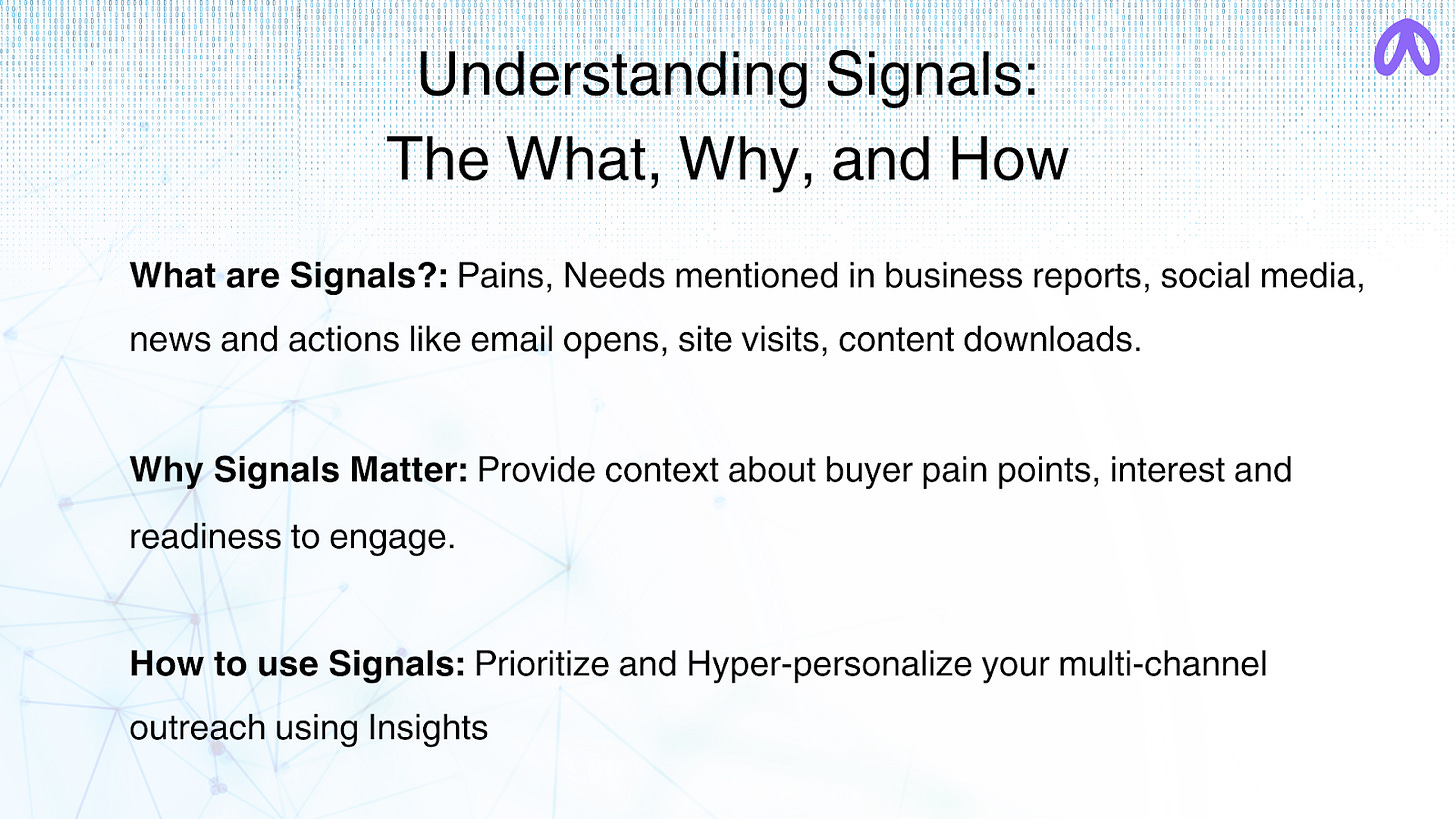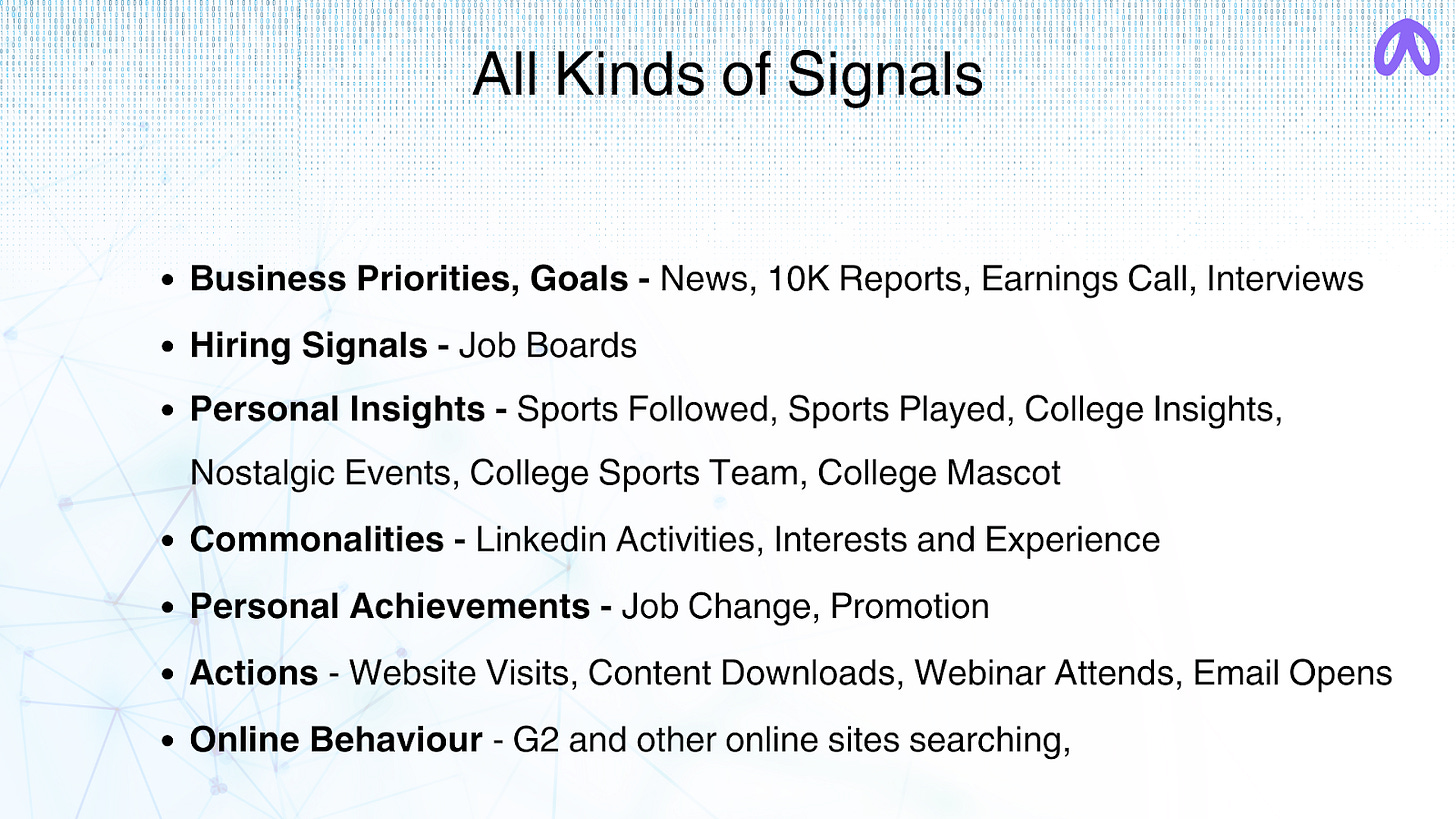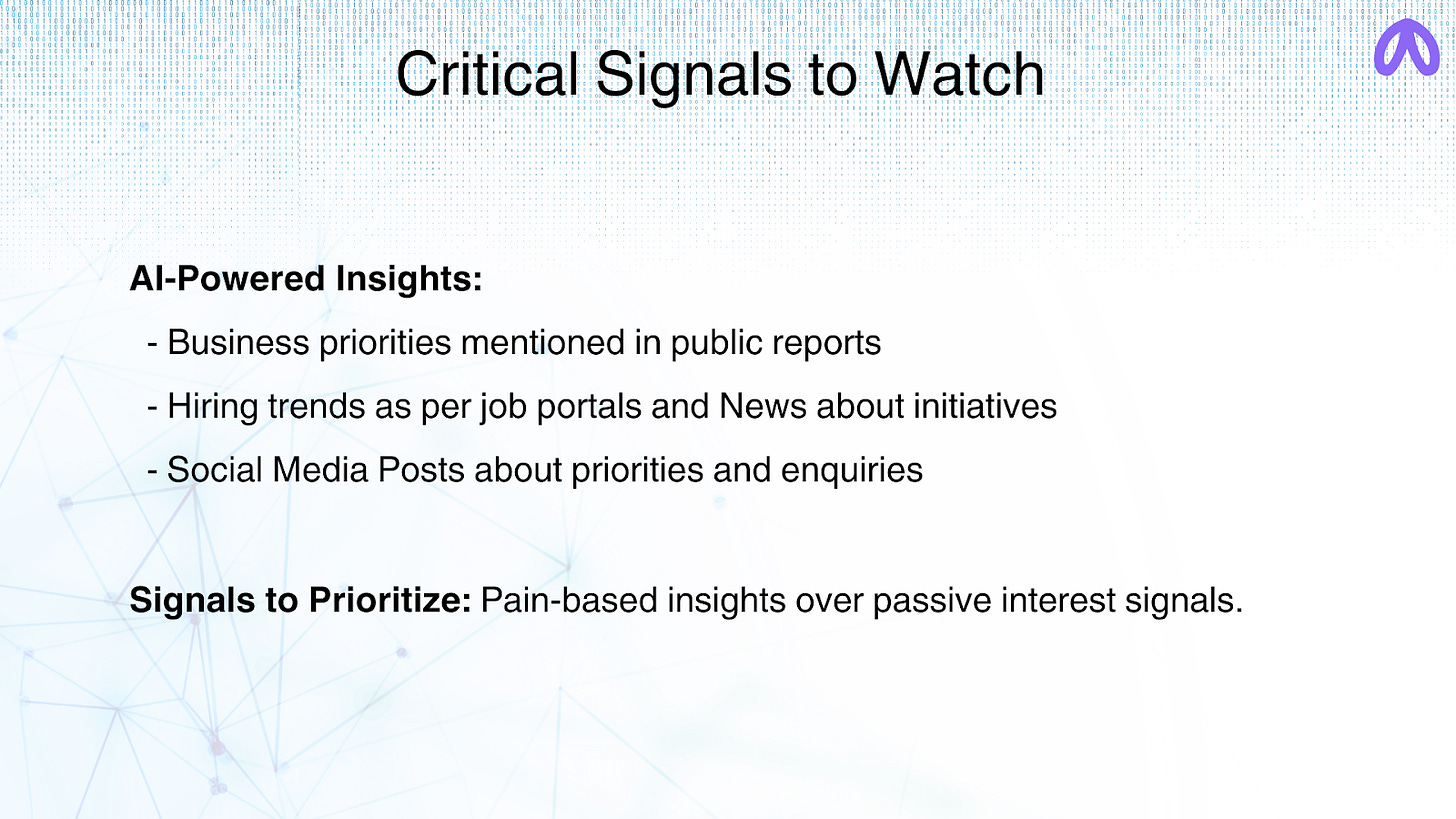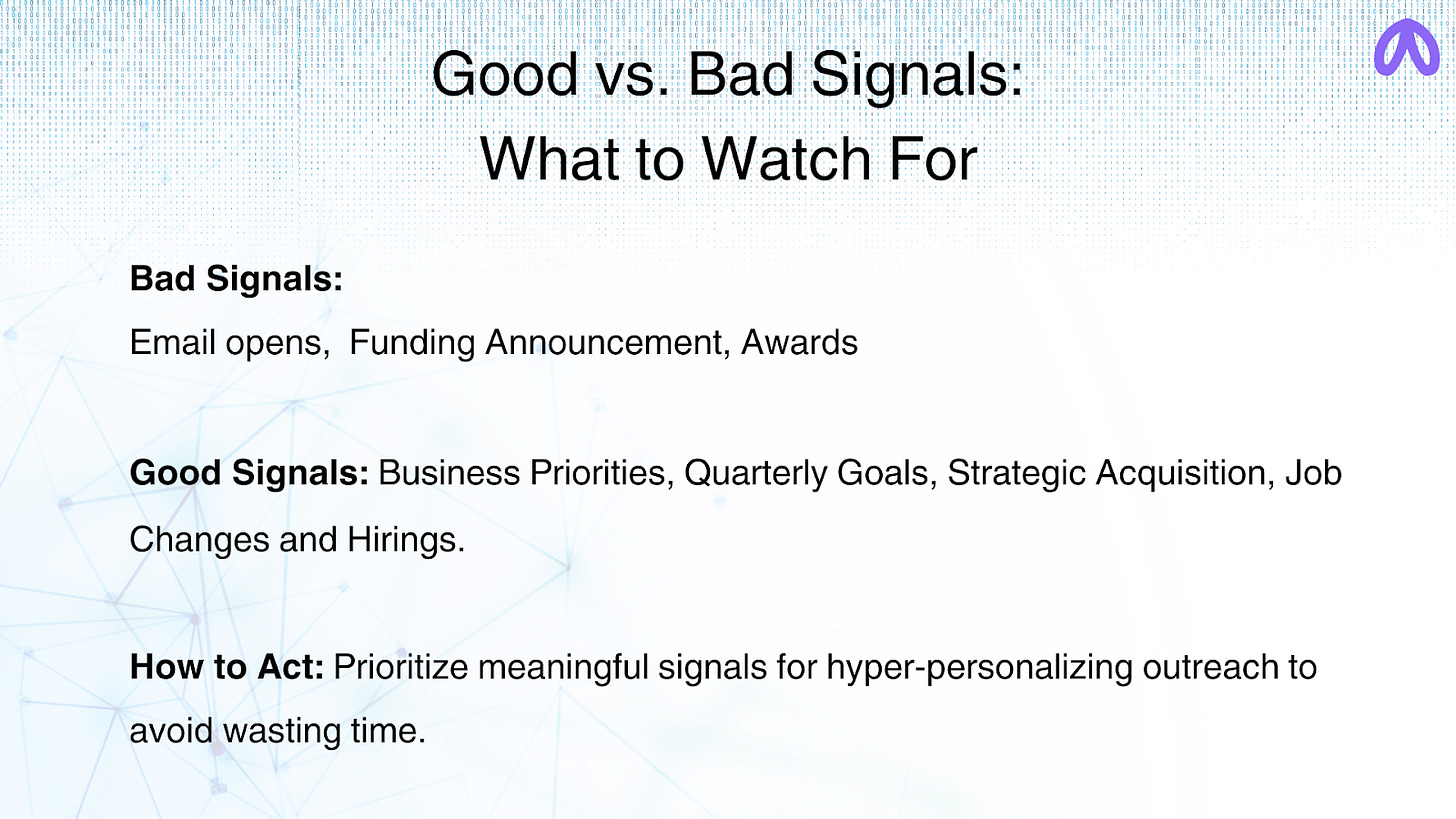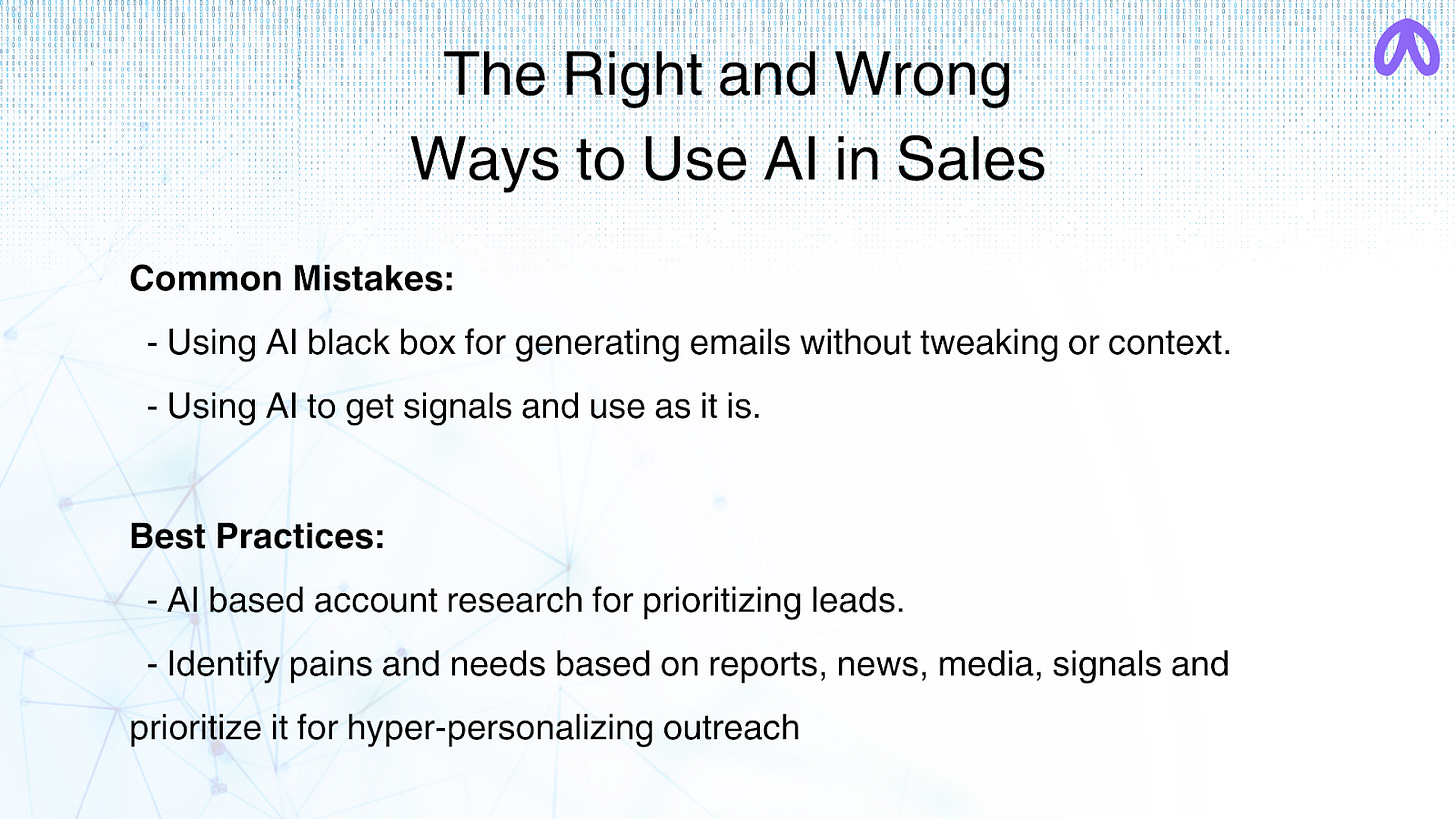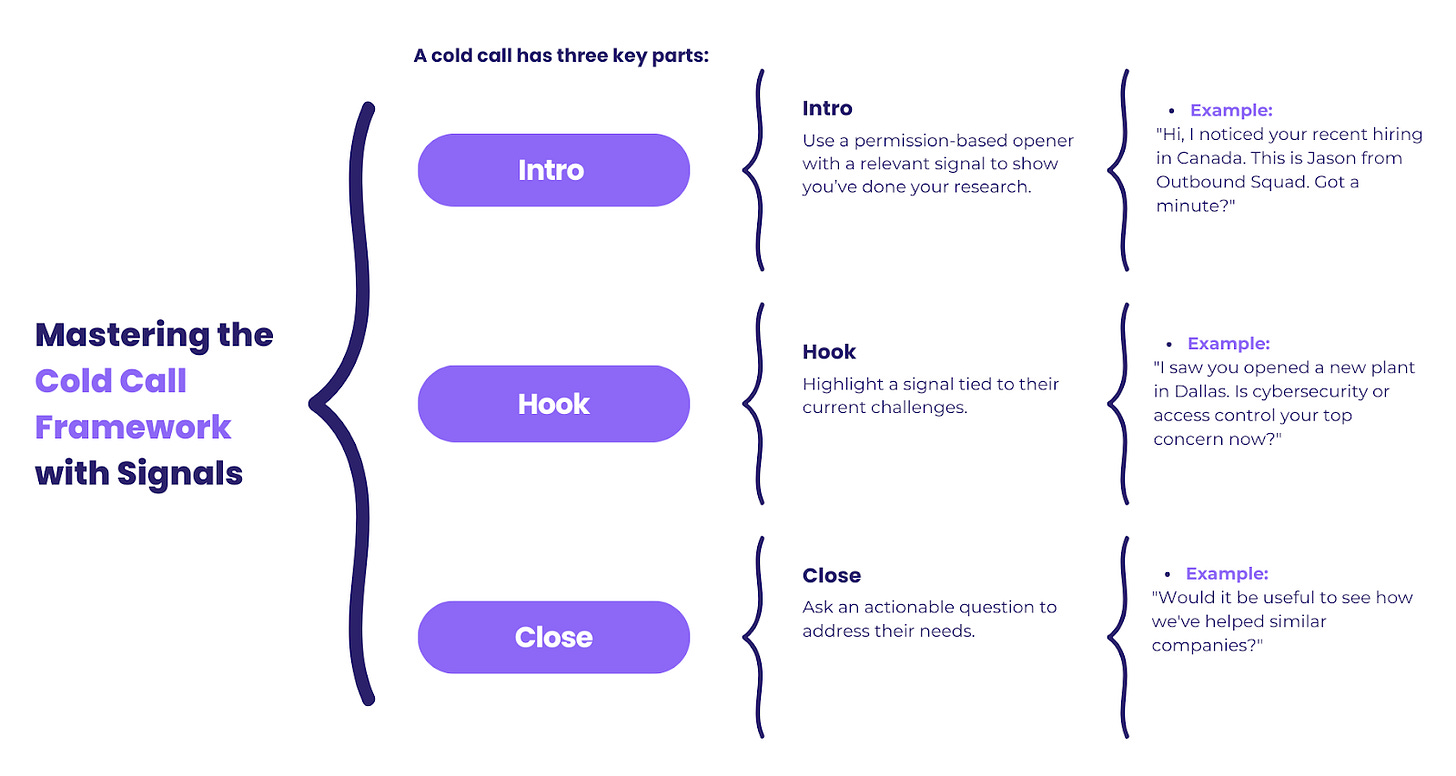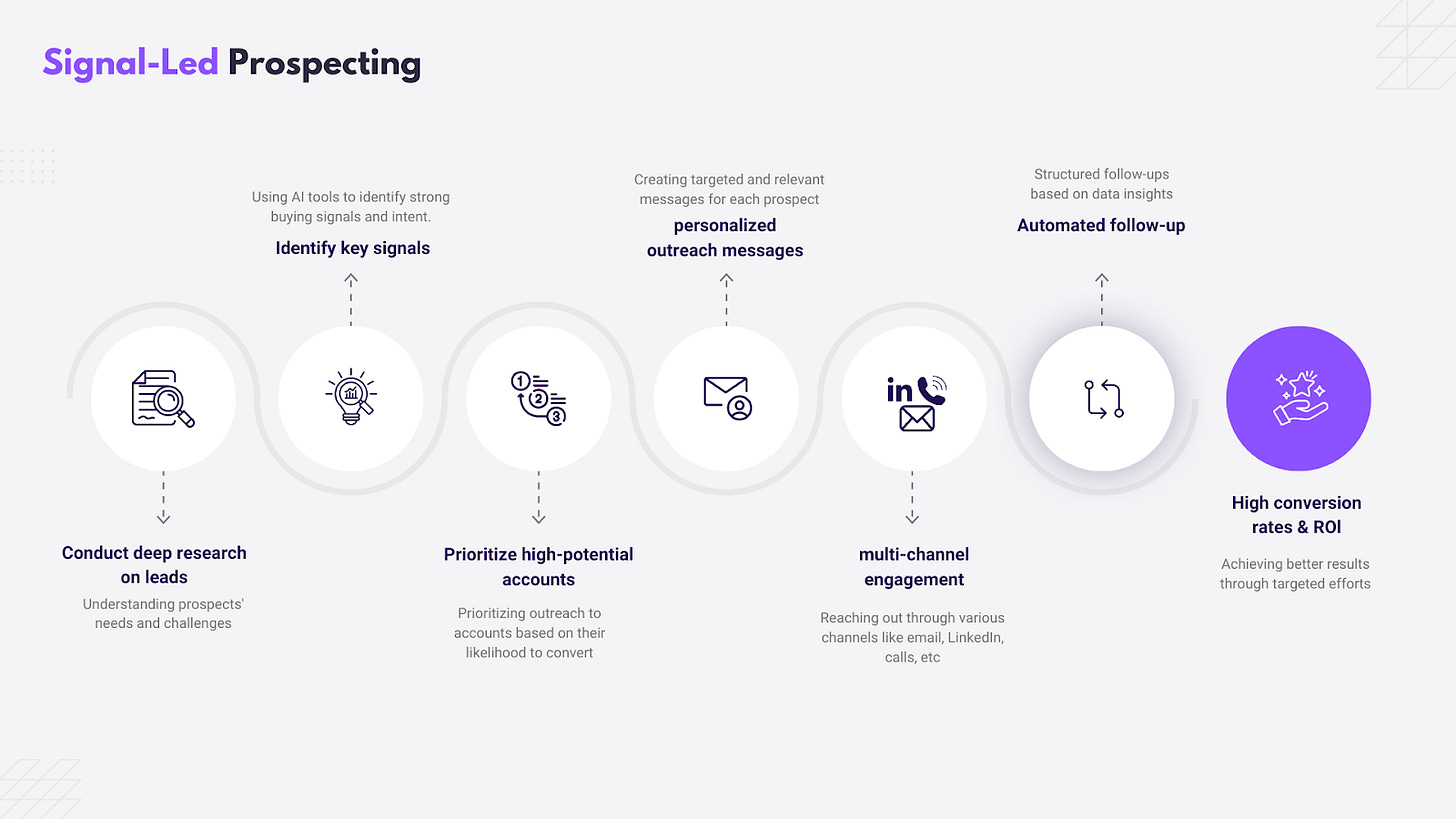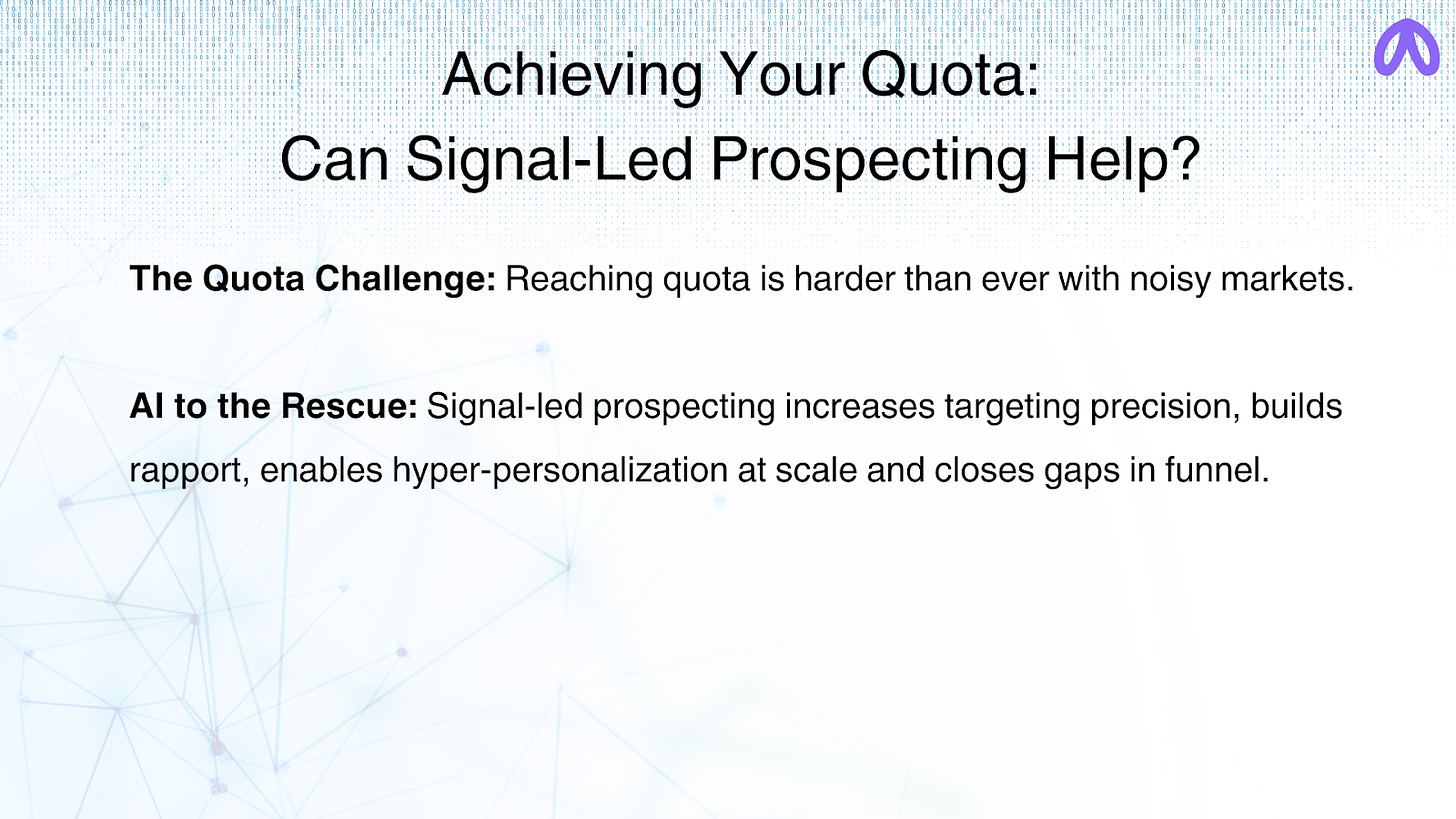Webinar Takeaways - AI-Powered Sales for hitting quota
Discover how AI-powered sales tools can supercharge your prospecting. We'll expose the biggest mistakes sales professionals make with AI, like relying on generic signals and personalization.
Last week we hosted Jason Bay (Founder, Outbound Squad) for a webinar on “AI-Powered Sales: Top mistakes to avoid and proven methods to hit quota”.
We covered following topics:
How is prospecting done today?
Understanding Signal-Led Prospecting
Utilizing AI for Signal Identification and Account Prioritization
Distinguishing Between Good and Bad Signals
Effective Use of Signals in Cold Outreach
Here is the link to entire recording…
How is prospecting done today?
There was a time when a simple cold email about a recent funding round was enough to grab a prospect's attention.
Those days are gone now.
Prospects are bombarded with generic, AI-generated messages. They can easily identify a templated email.
Hitting quota when everyone is using AI tools requires a new playbook.
Here's what's changed:
The "spray and pray" approach is not working anymore: Blasting out generic messages to hundreds of accounts doesn’t give any results. Today buyers want to know if you understand their unique challenges.
Deep research is non-negotiable: To truly understand your prospects, you need to do a deep dive in their problems and challenges.
The CFO is now your best friend (or worst enemy): The economic climate has made buying decisions more complex. CFOs are more involved, deals are scrutinized, and proving ROI is critical.
We’ve moved from the longest bull run in U.S. history to a market where every penny counts.
Buyers aren’t as freewheeling as they were in 2021. Jason shared, "It’s much easier to sell when people have money and aren’t worried about the economy." But today, selling is harder:
Deals now involve more stakeholders, often with the CFO stepping in late in the game. Someone from the audience mentioned how they had a deal approved by the CRO, but the CFO cut the budget in half at the last minute.
Deal sizes have decreased, with buyers favoring smaller commitments to reduce their risk.
Gartner’s stat is a wake-up call—56% of B2B buyers experience regret after a purchase. This means prospects are cautious, often second-guessing every decision.
So, how do you adapt?
It's about leveraging AI strategically. Imagine having a tool that scours the internet, analyzing earnings calls, 10K reports, and industry news, to pinpoint the exact pain points your prospects are facing.
That's the true power of signal-led prospecting. This isn't about replacing your role; it's about giving you the insights and tools to be more targeted, more relevant, and ultimately, more successful.
"AI is a great extra set of hands, but it's not an extra brain yet.”
“AI won't replace SDRs or account executives anytime soon. We’re still far from the day when AI can mimic the nuances of a cold call. But right now, it’s a tool that does the heavy lifting, freeing us up to be more strategic.”
Here is a recording of this section…
Understanding Signal-Led Prospecting.
It's not about jumping on generic triggers like funding announcements. Sure, a new funding round might suggest a company is growing, but it doesn't tell you if they're grappling with the specific challenges your solution addresses.
The real gold lies in identifying those pain-point-specific signals, the "insights" that tell a story about your prospect's needs.
Example: If you're a cybersecurity firm, a company announcing a new manufacturing plant might be a far more valuable signal than a funding announcement. This is because new plants often indicate potential vulnerabilities in their Operational Technology (OT) environment, a key area where cybersecurity solutions can make a difference.
But remember: Signal-led prospecting isn’t about following every signal that pops up. It's about knowing:
Which signals are most relevant to your industry and solution: This requires a deep understanding of your Ideal Customer Profile (ICP). What are their biggest pain points? What keeps them up at night? Once you know the answers, you can start identifying the signals that align with those challenges.
How to use those signals strategically in your outreach, without sounding robotic: Don't just inter-mix a signal with a generic email template. Instead, Think about how you can combine those insights into a natural, compelling narrative that speaks directly to your prospect’s unique situation.
Signal-led prospecting helps you:
Identify Intent: Know when a company is actively looking for a solution. Maybe they just announced a funding round, expanded to a new market, or hired a bunch of sales reps.
Understand Pain Points: Are they laying off staff? Launching a new product? These signals give you insight into their challenges.
Prioritize Outreach: By focusing on companies with the strongest buying signals, you waste less time and increase your chances of success.
In this market, selling isn’t about luck; it’s about signals. The more you understand your prospect’s challenges, the more effective your outreach will be.
Signal-led prospecting isn’t just a strategy—it’s the way forward in today’s AI-powered sales.
Utilizing AI for Signal Identification and Account Prioritization
AI excels at automating the intensive research tasks, freeing your time to focus on what really matters - building relationships and closing deals.
Here's how?
AI can analyze vast amounts of data from sources like news articles, company websites, social media, and financial reports to identify signals you might otherwise miss. It can spot insights in real time i.e. changes in hiring patterns, new product launches, expansions into new markets.
Not all signals are equal. AI helps you focus your efforts by prioritizing the signals that are most relevant to your specific solution and target market. This means you're not wasting time chasing after companies that are unlikely to convert.
AI can analyze a range of factors, like company size, industry, growth trajectory, and even the specific pain points they're experiencing, to score and rank your accounts based on their likelihood to close.
AI can hyper-personalize your outreach with the specific pain based insights it uncovers. Thus, ensure your emails and calls convert to meetings.
But here's the thing…
Just like any powerful tool, AI is only as good as the person using it. You need to provide clear instructions and guide AI towards the signals that matter most for your business.
Here's a real-world example from the sources:
Imagine you're selling a sales AI solution like Evabot. You could tell the AI to look for companies that are:
Facing growth challenges
Actively hiring sales professionals
Investing in their sales technology stack
By combining these signals, you can pinpoint companies that are not only a good fit for your solution but are also more likely to be responsive to your outreach.
Here's how AI identifies pain signals:
– AI can spot if a company is facing a growth challenge, such as rapid hiring or opening a new office. For example, a cybersecurity company might track signals like recent data breaches, while an HR tech company would monitor hiring patterns.
Your tech stack doesn’t need to be overloaded. Here are the must-haves:
- CRM: Centralize all your account data.
- Sales Engagement Platform: Streamline outreach and follow-up.
- AI-Powered Account Research Tool: Extracts real-time signals / insights and prioritizes accounts.
Here is a recording of this section…
Distinguishing Between Good and Bad Signals
Now, Let’ say you've got your AI tool giving you all sorts of signals and insights.
But hold on – before you reach a prospect, you need to know the difference between a signal that helps you book a meeting vs the one that fails.
Think of it this way:
A company announcing a new funding round is a signal. On the surface, it suggests growth and potential opportunities. But does it automatically mean they need your specific solution? Not necessarily.
Here's where many salespeople go wrong – they mistake a generic trigger for a personalized reason to connect.
Let's understand:
Using signals for prioritization vs. using them for outreach:
A funding announcement might be a perfectly valid signal for your AI to use when prioritizing accounts – it indicates a company might be in a growth phase.
However, leading with that same signal in your cold email ("Congrats on the Series B!") is unlikely to impress anyone. Why? Because every other salesperson is likely sending that same generic message.
Here is a recording of this section…
Focus on the "why" behind the signal, not just the signal itself:
As Jason points out, identifying a relevant trigger is just the first step. The real magic happens when you dig deeper to understand the underlying pain points that signal might reveal.
The Bad Signals: Overused and Misleading
- Funding Announcements: Yes, they indicate growth, but every SDR is already jumping on them. If you lead with, “I saw you raised Series A,” your email is just one of many.
- Awards and Public Recognition: These can seem like a great reason to reach out, but unless they tie directly into your solution, they often feel irrelevant.
Example: One attendee shared how they received countless emails saying, “Congrats on the funding!” but very few actually offered a relevant solution. It’s a signal, but it’s not the one to use in your opening line.
The Good Signals: Specific, Relevant, Actionable
- Hiring Patterns: Instead of just mentioning that a company is hiring, dig deeper. Are they hiring for a specific role, like a new security team? That indicates a potential need for cybersecurity solutions.
- New Product Launches or Expansions: This indicates a company is in growth mode, which might mean they need support in scaling or securing their new operations.
Example:
Imagine you're selling cybersecurity solutions. You see a company has just announced a major expansion, opening a new manufacturing plant. !
The generic approach: You fire off a congratulatory email mentioning the expansion and launch into your sales pitch.
Predictable? Yes.
Effective? Not so much.
The signal-led approach: You use that signal as a decision point to craft a more targeted message. You might point out the potential security risks associated with new manufacturing facilities, particularly within their OT environment. Suddenly, you've earned a trust to keep conversing.
Use signals strategically to:
Pinpoint the right accounts: Train your AI on the signals that indicate a genuine need for your solution within your target market.
Craft hyper-personalized outreach: Don't just mention a signal – use it as a base to ignite a conversation about your prospect's unique challenges and goals.
Position yourself as a trusted advisor, not just another salesperson: Offer valuable insights and showcase a deep understanding of your prospect's pains.
Initially, AI promised to revolutionize outreach, but instead, it ended up making it more challenging.
AI actually just did bad signals at scale. Here’s how:
Overused Signals: Now, everyone reaches out when a company raises funding, making this signal obsolete..
Generic Personalization: Too many emails start with, "Hey, I saw you’re hiring,” or, “Congrats on the funding!" These don’t feel personalized anymore—they feel automated.
By distinguishing between good and bad signals, and knowing how to leverage them in your outreach, you can cut through the noise and make your prospecting efforts far more effective.
The real power isn’t in finding the signals. It’s in using these signals to craft outreach that feels tailored, timely, and truly valuable.
Here is a recording of this section…
Effective Use of Signals in Cold Outreach
We've talked about the importance of distinguishing between good and bad signals. Now, let's get practical and see how you can actually use those signals effectively in your cold outreach to book more meetings and boost your conversion rates.
Most cold calls only last around 80 seconds, and the first 30-60 seconds are where deals are won or lost. As Jason put it, "Old calls are won and lost in the first 60 to 90 seconds." Using signals effectively can shift the odds in your favor.
Below is a breakdown of how to leverage these signals in both cold calls and emails.
Mastering the Cold Call Framework with Signals
A successful cold call has three main parts: Intro, Hook, and Close. Here’s how to make each part count:
1. Intro: Use a Permission-Based Opener
Start with a signal that immediately shows relevance.
Example: Instead of saying, "I’m calling about your sales training needs," try: "Hey, I was calling about all the hiring you’re doing in Canada right now. This is Jason from Outbound Squad. Do you have a minute? Promise to be brief."
This approach front-loads the signal, showing you’ve done your homework and have something specific to discuss.
2. The Hook: Drop the Priority
Highlight a signal that’s relevant to their current challenges or opportunities.
Example: "I noticed you just opened a new plant in Dallas. Typically, when companies like yours expand, they face two main challenges with cybersecurity: securing the OT environment and managing access control. Which one is a bigger focus for you right now?"
3. The Close: Engage with an Actionable Question
Now that you’ve shared a relevant signal, ask a question that prompts the prospect to think about their needs.
Example: "Would it make sense to explore how we’ve helped other companies like yours tackle these challenges?"
The "Front-Load Relevance" Opener:
Jason emphasizes the importance of grabbing your prospect's attention from the get-go, especially in a cold call where you only have seconds to make an impression. Instead of leading with a generic introduction ("Hi [Prospect Name], this is [Your Name] from [Your Company]..."), front-load your message with the relevant trigger that prompted you to reach out.
Example:
Let's say you're selling an HR solution, and you noticed a company is hiring aggressively in Canada. Here's how your cold call opener might look:
Generic Opener:
"Hi Jesse, this is Jason calling from [HR Solution Company]. I was hoping to speak with someone about your HR needs..."
Signal-Led Opener:
"Hey Jesse, I was calling about all the hiring you seem to be doing in Canada right now. By the way, it's Jason with [HR Solution Company]. Do you have a minute? I promise to be brief."
Why it works: You've immediately piqued their interest by demonstrating you've done your research and your call is directly relevant to their current priorities.
The "Priority Drop" Technique:
Once you've established relevance, don't waste time getting to the heart of why you're calling. Jason recommends using a "priority drop" to quickly establish the value proposition of your call.
Example:
Imagine you're selling to clinical operations professionals. You've identified a company that recently launched a new clinical trial. Here's how you could incorporate a priority drop:
After your signal-led opener, continue with:
"I know I'm calling out of the blue, but do you have a quick minute for me to share the reason for my call, and you can decide if you want to keep chatting? I noticed you just launched the [ABC Study]. Typically, when I talk to clinical operations folks like you who are launching these types of studies, one of two things tends to be top-of-mind – reducing startup timelines or improving patient retention. Which one of those is a bigger focus for you right now?"
Why it works: You've acknowledged you're interrupting their day, clearly explained the purpose of your call, and offered them a choice (continue or disengage) while highlighting the value of engaging further.
Email Outreach – The Signal-Driven Framework:
The same principles apply to email outreach. Your signal shouldn't be just copy-paste – it should be a part of your message.
Jason's Recommended Email Structure:
Subject Line: Include the trigger to instantly grab their attention. (e.g., "Saw you just got FDA approval for [Product Name]")
Opening Line: Directly reference the trigger and tie it to a common problem your solution addresses.
Example: "I noticed you just launched a new study on XYZ. We’ve helped companies like yours streamline patient recruitment for similar trials.
Social Proof: Include case studies or testimonials from similar companies that have benefited from your solution.
Example: "We recently helped [similar company] reduce their recruitment time by 30%."
Call to Action: End with a clear and concise call to action, inviting them to learn more or schedule a call.
Example: "Interested in a quick chat to see how we can help you?"
Key takeaway: AI can be your secret weapon for identifying these precise signals, but it's up to you to use them strategically and craft compelling outreach that just makes an impact with prospects.
The Email Combo Strategy
Jason mentioned a three-email combo approach:
- Email 1: Use the signal to establish relevance.
- Email 2: Follow up with a case study.
- Email 3: A quick “any thoughts?” prompt.
Using signals in cold outreach is about more than just mentioning them—it’s about integrating them into a narrative that speaks directly to your prospect’s pain points and goals.
By effectively embedding these signals, you make your outreach more targeted, relevant, and, ultimately, more successful.
Here is a recording of this section…
Evabot AI for Signal-led Prospecting
Want to see how these AI-powered insights translate into more meetings?
Let's look at Evabot, a tool specifically designed to help you leverage signals for targeted outreach.
1. Customize the AI to Your Needs:
Instead of relying on generic signals, the tool allows you to customize its analysis based on your unique products, target audience, and the specific triggers that matter most to your business.
Example:
Imagine you're selling Evabot itself! Here's how you might set up the tool:
Product/Solution: Sales AI solution (Evabot)
Target Persona: Sales leaders, SDRs, BDRs
Key Pain Points: Growth challenges, inefficient prospecting, low conversion rates
Signals to Track:
- Companies facing growth challenges (e.g., hiring surges, new market expansions)
- Companies actively hiring sales professionals
- Companies investing in sales technology (e.g., using Salesforce, implementing new tools)
2. Real-Time Insights and Account Scoring:
Evabot scans the internet, analyzing everything from company websites and news articles to financial reports and social media activity. It then uses this data to score and rank your accounts based on their relevance.
Example:
Say you're targeting Zscaler, a cybersecurity company. Evabot might uncover insights like:
Zscaler is shifting towards an account-centric sales motion.
They're experiencing rapid growth (e.g., 30% year-over-year revenue increase).
They're actively hiring for sales roles.
Evabot would then highlight how these insights align with your solution's strengths, making it clear why Zscaler is a high-potential prospect.
3. Actionable Insights at Your Fingertips:
Evabot doesn't just present you with a data dump – it provides actionable insights you can use directly in your outreach.
Example:
When preparing for a call with Zscaler, your sales rep could use Evabot to generate call-prep script that:
Identify relevant triggers: Quickly surface the insights about Zscaler's account-centric sales approach and rapid growth.
Craft a "front-load relevance" opener: "Hi [Prospect Name], I was calling about Zscaler's recent shift towards an account-centric sales model..."
Personalize the "priority drop": "We've seen companies like yours experiencing rapid growth often struggle to maintain consistent messaging and outreach as their sales teams expand. Is that something you're facing at Zscaler?"
4. Seamless Integration for Streamlined Workflows:
Evabot integrates with your existing CRM and sales engagement tools, so you can easily access these AI-powered insights within your familiar workflows.
Example:
When drafting an email to Zscaler, Evabot can:
Suggest relevant email templates: Offer a framework that aligns with the identified triggers like PSA, OPPS etc
Auto-populate personalized content: Pull in specific insights about Zscaler's challenges and goals directly into the email.
Maintain brand consistency: Ensure your messaging adheres to your company's brand voice and style guidelines.
Tools like Evabot are changing the game for sales professionals, empowering them to work smarter, not harder.
By leveraging AI-driven insights, you can ditch the generic outreach and engage your prospects with the hyper-personalized, value-driven conversations that book more meetings and close deals.
Here is a recording of this section…
Questions
In every webinar, there’s always a Q&A segment that highlights some of the most pressing concerns.
Here’s a detailed look at the questions from the webinar, offering insights on how AI is reshaping sales..
Q1: Can SDRs be replaced by AI?
Short answer: No.
Analysis:
The concern about AI replacing SDRs (Sales Development Representatives) is valid, but Jason made it clear that this isn’t happening anytime soon. He emphasized, “If your skill level as an SDR is just sending out mass blast emails, then yes, you might get replaced.” But AI can't replicate human interactions on the phone or the nuances of building rapport.
Takeaways:
- Cold Calling Isn’t Dead: Companies like Rippling still generate 50% of their meetings via phone calls, and AI simply can’t replace that human touch.
- Be Phone-Ready: If you can’t set meetings over the phone, you’re more likely to be replaced. Cold calling is where skilled SDRs make their mark.
Example: Jason cited how AI handles mundane tasks like finding triggers and contact information, but connecting with prospects on the phone or social media still requires a human touch.
Q2: What are the best lead magnets for engaging a technical audience (CIOs, CISOs, etc.)?
Effective Tactics:
- In-Person Get-Togethers and Dinners: A senior audience responds well to real-world interactions. Invite 15-20 executives for dinner and facilitate a meaningful discussion.
- Leverage Industry Expertise: Partner with consultants who have held similar roles to your target audience. This builds credibility and opens doors.
Example: Jason highlighted how one of his clients employs ex-CISOs as consultants and hosts in-person dinners to engage with prospects—an approach that’s proven to be highly effective.
Q3: Is Cold Calling still king in Education Sector Sales?
Yes, cold calling remains highly effective in the education sector, especially when selling to K-12 schools and districts.
Why It Works:
- Main Lines Are Always Answered: Schools always have someone picking up the phone, so cold calling is still an efficient way to reach decision-makers.
- Gatekeeper Skills Matter: Getting past gatekeepers is crucial in this sector. Offer valuable insights to engage them.
Tip: Utilize annual reports, which public schools often share, to gather insights before making the call.
Q4: What are unconventional data sources for creating a Point of View (POV)?
Jason suggested that Evabot is a creative tool for gathering unconventional insights. It automates the process of finding triggers, letting you focus on crafting your POV.
Alternative Approach:
- Check industry conferences, even if you don’t attend. Look at the speaker list, topics, and recordings to understand current trends and challenges.
Example: Look up speakers’ content on LinkedIn or podcasts to gain insight into industry pain points and align your POV accordingly.
Q5: How do you transition a "Nice-to-Have" solution to a "Must-Have"?
Being labeled as a "nice-to-have" is more of a mindset issue than a reality. Jason shared that aligning your solution with your prospect's core business priorities makes all the difference.
Steps to Take:
1. Understand Their Goals: Early in your sales cycle, ask prospects, “If you implemented our solution, how would you measure ROI in 6 to 12 months?”
2. Tie Your Solution to C-Suite Outcomes: If you sell to pharma or med device companies, connect your solution to revenue generation, profitability, or operational efficiency.
Gartner's Study: More than 90% of B2B executives only purchase solutions that align with their core business priorities. Make sure your pitch is aligned accordingly.
Q6: Is AI capable of creating effective cold outreach strategies?
AI helps but doesn’t replace the need for human involvement in cold outreach. Evabot, for instance, assists with signal identification, but it doesn’t replace the creativity and personalization that effective outreach requires.
Jason’s Insight: "AI gathers information, but crafting a compelling POV still requires human input."
Q8: Is Robo Cold Calling legal?
No, it’s still illegal in most cases. Human-driven cold calling remains the standard and isn’t going away anytime soon.
Final Takeaways
- SDRs and BDRs Are Here to Stay: AI is a powerful tool, but it won’t replace the human touch in sales.
- Leverage Automation, Don’t Rely on It: Use AI tools like EvaBot to streamline processes, but maintain a human touch in your outreach.
- In-Person Engagement Is Powerful: For senior and technical audiences, face-to-face interactions (even virtually) make a significant impact.
- Make Your Offer Irresistible: Provide value in your outreach, like sharing reports or benchmarks that prospects can’t get elsewhere.
Would you like to evaluate “Evabot AI” for signal-led prospecting and book more meetings? Book a meeting on the button below.
If you’re not a subscriber, here’s what you missed earlier:
Subscribe to get access to our weekly posts on Prospecting, Automation, AI, Revenue Growth and Lead Generation.





